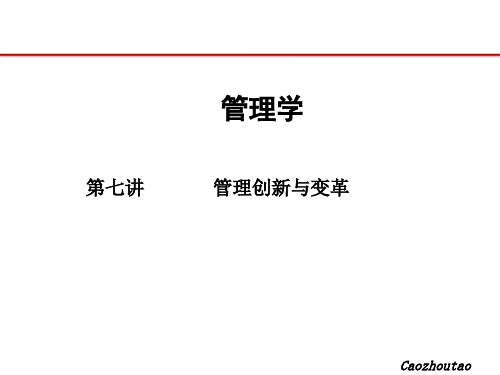管理学课件第13章变革及创新管理ManagingChangeandInnovation
第十三章 管理变革与创新

第十三章管理变革与创新第十三章管理变革与创新TRUE/FALSE1. 经济和技术的发展已经使越来越多的公司走出国界,到世界其他国家开展业务。
ANS: T2. 追求世界先进水平是一个虚幻的、不切实际的、不必要的目标,因此对企业来说无关紧要。
ANS: F3. 世界一流企业都具有“创新至上”的价值观。
ANS: T4. 全球性市场逐步形成使得企业的规模发展都呈现规模扩大趋势。
ANS: F5. 管理变革不能等出了问题才实施,而应在企业处于安乐时主动地进行。
ANS: T6. 企业在进行管理变革时不可避免的会遇到阻力,因此可以不予理睬。
ANS: F7. 谈判是解决阻力的一种必要的策略,虽然其潜在的成本很高,但是这种方式不存在风险。
ANS: F8. 产品市场步入了从生产者导向走向以顾客需求为导向的新的市场时代。
ANS: T9. 日本企业引进美国的工业工程哲理和管理模式,进行本土化改造,并取得成功。
ANS: T10. 当今社会已步入知识经济时代,但资本仍然是主导的生产要素和资源。
ANS: F11. 一个组织能否取得短期与长期成功,这取决于该组织的变革能力。
ANS: T12. 现代管理思想开始从“物本主义”向“人本主义”转变。
ANS: T13. 企业制度从以资本为中心,资本雇佣劳动,股东占有企业的传统模式将逐渐转变为以知识为中心,知识统帅资本,股东和职工共同拥有企业的模式。
ANS: T14. 企业要重视先进生产运作管理方法,信息技术的运用则无关紧要。
ANS: F15. 在管理策略变革方面,企业必须注重提高核心竞争力,而树立全球化的观念则是空中楼阁。
ANS: F16. 崇尚知识和创新成为企业新的价值观,成为企业文化的灵魂。
ANS: T17. 企业文化可以进行模仿和复制。
ANS: F18. 世界级企业注重长期目标,对于短期如每月的营业业绩则无关紧要。
ANS: F19. 一个组织能否取得短期与长期成功,这取决于该组织的变革能力。
管理学管理创新与变革ppt课件

Source: Business Week, August 1, 2005
Caozhoutao
避免失败的程式
1. 设置专题讨论会 2. 消除障碍 3. 分享个人经验 4. 引入圈外人 5. 证明你自己是错的,而不是对的 6. 庆祝明智的失败
“创新的矛盾在于成功总是伴随着失败”
Source: Business Week, July 10, 2006
要求: *多年视野 *持续压力 *推进社会化 *始终如一的推行新的 组织架构
Caozhoutao
失败的变革尝试和成功的秘诀
1. 没有制造出足够大的危机感 2. 没有创造出一个有足够影响力的领导团队 3. 缺乏令人信服的远景规划 4. 缺乏与员工们的沟通
Caozhoutao
失败的变革尝试和成功的秘诀
第七讲
管理学
管理创新与变革
Caozhoutao
学习目标
1. 解释范式转换的产生并论述其后果 2. 识别组织惯性的主要来源 3. 概述一家老牌企业进行战略和组织变革的条件 4. 解释大量组织变革失败的原因,并指出管理者避免失败的方法 5. 论述管理者增强组织成功创新能力的做法
Caozhoutao
范式转换
• 创新产品需求固有的不确定性 • 新技术缺乏商业化的潜力 • 较差的战略 ,包括不合适的定价、宣传的缺乏、或较
差的分销战略 • 推销一种缺乏市场需求的技术
Caozhoutao
可怜的创新成功率
所有产业的自主创新成功率是 4.5%
产业 • 玩具 • 百货 • 音乐 • 航空 • 移动电话
成功率 >1% >2% >2% 2% 3%
新的商业模式
• 一家企业计划获取收益的方式
创新与变革管理ppt课件

1.2 创新管理在我国的现实意义
• 产业/企业面临的挑战和紧迫任务
• 中国企业的技术成长阶段
• 中国企业的技术能力成长
• 中国企业技术管理模式
• 我国企业面临的挑战和机会
25
1.2.1产业/企业面临的挑战和紧迫任务
• (1)国际
– 人均GDP达到1000美元 经济自动进入起飞阶段? – 20世纪80年代以来, 先后16个国家人均GDP达到1000 美元,现仍保持在1000美元以上的:7个,不升反降的: 9个 – 发展中国家的追赶多数都不成功
18
19世纪的技术创新
• 蒸汽机:瓦特,1770-1780年
• 铁制船:Isambard Kingdom Brunel,182045年 • 火车头:史蒂文森,1829年 • 电磁感应发电机:法拉第,1830-40年 • 电灯泡:爱迪生与Joseph Swan,1879-90年
19
更近的技术创新
• 圆珠笔:雷诺国际钢笔公司(Reynolds International Pen Company),1945年 • 浮法玻璃制造工艺:Pilkington,20世纪50年代 • 善胃得(治疗溃疡的药物):Glaxo,20世纪70-80年代 • 复印技术:施乐公司,20世纪70/80年代 • 个人电脑:苹果电脑公司,20世纪80年代
– 我们能够从研究和经验中学到些什麼? – 是否存在着可以指导行动的模式?
23
管理技术创新的难度
• 创新是商业成功的核心……但是:
– 在原型阶段的创意有90%以上的失败 – 在每4种完全开发的产品中,只有1种会获得成 功 – 每推出3种产品,只有1种会获得成功
• 换句话说:60件创意--5件原型--3件商品化-2件上市--1件赚钱 24
胡望斌管理学课件——第十三章创新

17
创新的特性
创新的主体是企业。
创新是一种经济行为,其目的是获取潜在的利润, 市场实现是检验创新成功与否的标准。
关键词: 创新——企业生命的本源!
11
创新例子
Toshiba(1952): 打破“电扇只能漆成黑色”的束缚
(英)Stevenson:
火车不用齿轮、齿轨;换平轮、平轨,提高速度5-10倍
(上海)保温瓶厂: “以镁代银,镀膜、改进保温”
中国真丝 与外国的“仿真丝”、“超真丝”、“新纤维”
12
3.实施促进自主创新的政府采购
2. 国家“十一五”科学技术发展规划
(全国人大十届四次会议2006年3月 ) “十一五”是我国全面落实科学发展观,把增强自主创新能力作为国家战略。 1.总体思路
以邓小平理论和“三个代表”重要思想为指导,全面落实科学发展观,大力实施 科教兴国战略和人才强国战略,坚持“自主创新,重点跨越,支撑发展,引领未来” 的指导方针,把自主创新作为主线,将组织实施重大专项作为战略突破点.
企
业 成
创新型企业
长
灵活型企业
质量型企业
效率型企业
时间
未来企业须转向创新型
14
二、创新理论
创新:一个存在普遍分歧的领域
创新的重要意义:innovation or die
创新已经成为新的信仰,然而,关于它究竟是什么以及如何培育创新,仍是 一个存有困惑的问题。
[英]Nicholas Valery著,战洪起等译,《工业创新》(Innovation in Industry),清华大学出版社,1999年,第1页。
(1)古典经济学家寻求在稳定环境中最大限度地利用现有经济资源,任何干扰都视为外生的;
(2)熊彼特认为经济在大多数情形下处于非均衡状态,不断受到“技术创新”的扰动,从而产生“经济长 波”。
变革管理与创新

groups)]
▪ 經由非結構性的團體互動,來改變行為的訓練方式。
▪ 成員聚集在一個自由而開放的環境下,由一位行為學 家在旁引導進行討論及互動。
▪ 目的在於使個人更瞭解自己的行為,瞭解別人對自己 看法,對別人言行更具敏感度,以及增進個人對團體 程序的瞭解。
案例
▪ 訓導處學務處 ▪ 終身教育學院 ▪ 資訊系統發展中心 ▪ 一部與二部之行政單位合併 ▪ 統一集團事業部之擴充… ▪ 學校成立環安室、性學研究所、行銷與物
流系
變革管理與創新
1
影響組織變革的類型
科技的
機器 設備 製成 自動化 電腦 新物原料 機器人
環境的
法律 租稅 社會趨勢 流行趨勢 政治趨勢 經濟趨勢 利率 消費者趨勢 競爭 供應商 人口趨勢
▪ 在大多數變革的情境中,必定在一些有利於變 革的力量,亦存在一些抵抗變革的力量。為促 使變革的成功,經理人應先列出這些力量,然 後設法顛覆平衡狀態,使得促進變革的力量能 夠壓阻礙變革的力量。
變革管理與創新
26
組織發展
(organizational development,OD)
包含一連串中介的計畫性變革,重視人性
入新的觀念
變革管理與創新
4
計畫性變革與反應性變革
▪ 計畫性變革(planned change)
▪ 關於結構性創新、新的政策或目標,或者經營 哲學、組織氣候與風格的改變等之深思熟慮的 設計或執行。
▪ 反應性變革(reactive change)
▪ 指當事件發生時,公司採取一些片斷步驟來回 應。
管理变革与创新培训课件(PPT 56页)

3、日常业务流程—公司运营系统中的所有
流程的分类
决策流程:
• A、股东、董事、监事会等组建流程; • B、公司战略、重大问题及投资流程; 业务流程:
• A、企业内部业务流程(职能部门); • B、企业外部业务流程(上游下游);
3级流程清单(示例)
减少到9个步骤
流程开始
流程结束
流程规划图(示例)
基 战略
战略管理流程
础 经营计划 经营计划管理流程
管 财务
财务管理流程
理
人力资源 管理体系 人力资源管理流程
管理体系策划流程
管理评审流程
管理改进流程
采购
供 应
供应商选择流程
链
原料采购 流程
供应商评估流程
质量投诉 流程
生产工艺 工艺流程1
生产工艺 工艺流程2
通过管理评审,发 现改管进理管.缺理陷水平,持,续改
善组织绩效
管理体系实施
周密的推进计划 完整的运作体系 有效的控制手段 必要的资源保障
管理体系评审
市场表现 财务表现
企业的“业绩理念指纹”
• 五个基本要素
使命/抱负
目标 流程与组织
业绩反馈
业绩奖惩 管理
“业绩理 念”指纹
可供选择的 控制协调与激励“杠杆”
一级流程
二级流程
三级流程
营销管理流程 营销计划制定流程
市场研究流程
广告效果评估流程
产品定价流程
市场开发流程
新市场开发流程
经销商管理流程
市场推广流程
展会推广流程
……
……
COPQ冰山理论
传统看法
第十三章新变革与创新管理新

第十三章变革与创新管理学习内容█什么是变革█变革的力量□外部力量□内部力量□管理者作为变革推动者█变革过程的两种不同观点□风平浪静观□急流险滩观□对上述两种观点的认识█变革管理□变革的类型□应对变革的阻力█变革管理中的新问题□组织文化变革□处理员工压力█激发创新□创造与创新□创新的激发与培育█本章小结█思考题学习目标阅读和学完本章后,你应该能够:01.对比关于变革的“风平浪静”与“急流险滩”两种观点。
02.描述管理者能对组织作些什么变革。
03.解释人们为什么会抵制变革。
04.列示降低变革阻力的策略。
05.说明促进组织文化变革的情境因素。
06.解释流程再造与变革有什么关联。
07.描述减轻员工压力的办法。
08.说明创造与创新的区别。
09.解释组织如何能激发和培育创新。
桑切斯—洛尔扎在教育员工认识变革的意义和必要性方面所面临的管理难题,绝不是这家公司独有的。
无论是大公司、小企业,还是大学或学院、州级和市级政府机构,或是军队,它们都不得不大大地改变以往做事的方式。
虽然变革总是管理者工作的一个组成部分,但它近年来已愈显重要。
本章将说明为什么变革如此重要,管理者如何管理变革。
我们还将阐述管理者用以培育创新和增进组织适应性的各种办法。
█什么是变革--------------------------------------------------------------------------要不是为了推进组织变革(organizational change),即在人员、结构或技术方面的任何改变,管理者的工作会相对容易得多。
计划工作将简单得多,因为明天会与今天没多大差别。
组织有效设计的问题也可以得到解决,因为环境没有了不确定性,组织也就不存在适应的需要。
类似的,决策制定也会大大地简化,因为每一方案的结果都几乎可以绝对准确地加以预见。
确实,如果竞争者不推出新的产品或服务,顾客不产生新的需求,政府不对法规进行修改,或者员工的需要不发生变化,那么,管理者的工作就简单多了。
chap13-management

13-7
The Change Process
13-8
Two Views Of The Change Process (cont.)
White-Water Rapids Metaphor – consistent with uncertain and dynamic environments – consistent with a world increasingly dominated by information, ideas, and knowledge – managers must continually maneuver in uninterrupted rapids • managers face constant change – today, managers must be ready to efficiently and effectively manage the changes facing their organizations or their work areas
13-12
Managing Change (cont.)
Type of Change (cont.) – changing people - changes in employee attitudes, expectations, perceptions, and behavior • organizational development (OD) - techniques or programs to change people and the nature and quality of interpersonal work relationships –intended to help individuals and groups work together more effectively
